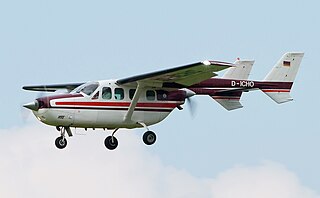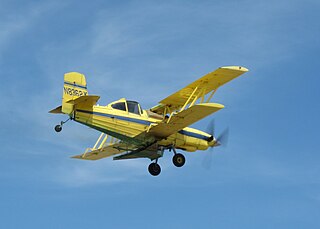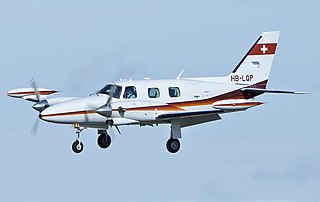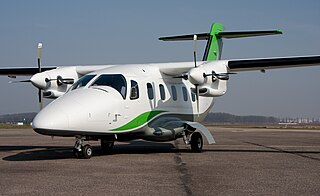
The Douglas DC-3 is a propeller-driven airliner manufactured by Douglas Aircraft Company, which had a lasting effect on the airline industry in the 1930s to 1940s and World War II. It was developed as a larger, improved 14-bed sleeper version of the Douglas DC-2. It is a low-wing metal monoplane with conventional landing gear, powered by two radial piston engines of 1,000–1,200 hp (750–890 kW). The DC-3 has a cruising speed of 207 mph (333 km/h), a capacity of 21 to 32 passengers or 6,000 lbs (2,700 kg) of cargo, and a range of 1,500 mi (2,400 km), and can operate from short runways.

The Pratt & Whitney Canada PT6 is a turboprop aircraft engine produced by Pratt & Whitney Canada. Its design was started in 1958, it first ran in February 1960, first flew on 30 May 1961, entered service in 1964 and has been continuously updated since. It consists of two basic sections: a gas generator with accessory gearbox and a free power turbine with reduction gearbox, and is often seemingly mounted backwards in an aircraft in so far as the intake is at the rear and the exhaust at the front. Many variants of the PT6 have been produced, not only as turboprops but also as turboshaft engines for helicopters, land vehicles, hovercraft, and boats; as auxiliary power units; and for industrial uses. By November 2015, 51,000 had been produced, had logged 400 million flight hours from 1963 to 2016. It is known for its reliability with an in-flight shutdown rate of 1 per 651,126 hours in 2016. The PT6A covers the power range between 580 and 1,940 shp while the PT6B/C are turboshaft variants for helicopters.

The Cessna Skymaster is an American twin-engine civil utility aircraft built in a push-pull configuration. Its engines are mounted in the nose and rear of its pod-style fuselage. Twin booms extend aft of the wings to the vertical stabilizers, with the rear engine between them. The horizontal stabilizer is aft of the pusher propeller, mounted between and connecting the two booms. The combined tractor and pusher engines produce centerline thrust and a unique sound. The Cessna O-2 Skymaster is a military version of the Cessna 337 Super Skymaster.

The Ayres Thrush, formerly the Snow S-2, Aero Commander Ag Commander, and Rockwell Thrush Commander, is an American agricultural aircraft produced by Ayres Corporation and more recently by Thrush Aircraft. It is one of the most successful and long-lived agricultural application aircraft types in the world, with almost 2,000 sold since the first example flew 66 years ago. Typical of agricultural aircraft, it is a single-seat monoplane of conventional taildragger configuration. Originally powered by a radial piston engine, most examples produced since the 1980s have been turboprop-powered.

The Cessna 441 Conquest II is the first turboprop powered aircraft designed by Cessna, and was meant to fill the gap between their jets and piston-engined aircraft. It was developed in November 1974, with the first aircraft delivered in September 1977. It is a pressurized, 8–9 passenger turbine development of the Cessna 404 Titan.

The Grumman G-164 Ag Cat is a single-engined biplane agricultural aircraft, developed by Grumman in the 1950s.

The PZL 130 Orlik is a Polish turboprop, single engine, two seat trainer aircraft.

The Cessna 425, known as the Corsair and later as the Conquest I, is an eight-seat American pressurized turboprop twin-engined light aircraft. Now out of production, it was built by Cessna Aircraft of Wichita, Kansas, between 1980 and 1986.

The Piper PA-31T Cheyenne is a turboprop development of the earlier PA-31P Pressurized Navajo.

The Beechcraft Model 99 is a civilian aircraft produced by Beechcraft. It is also known as the Beech 99 Airliner and the Commuter 99. The 99 is a twin-engine, unpressurized, 15 to 17 passenger seat turboprop aircraft, derived from the earlier Beechcraft King Air and Queen Air. It uses the wings of the Queen Air, the engines and nacelles of the King Air, and sub-systems from both, with a specifically designed nose structure.

The Cessna Citation II are light corporate jets built by Cessna as part of the Citation family. Stretched from the Citation I, the Model 550 was announced in September 1976, first flew on January 31, 1977, and was certified in March 1978. The II/SP is a single pilot version, the improved S/II first flew on February 14, 1984 and the Citation Bravo, a stretched S/II with new avionics and more powerful P&WC PW530A turbofans, on April 25, 1995. The United States Navy adopted a version of the S/II as the T-47A. Production ceased in 2006 after 1,184 of all variants were delivered.
The Soloy Pathfinder 21 was a twin-engined, single-propeller, turboprop aircraft. It is a modification by Soloy Aviation Solutions of a Cessna 208 Caravan airframe. First flown in 1995, the aircraft was essentially a stock Cessna 208 airframe that has been stretched by 72 inches (1.83 m) with structural reinforcement, powered by twin Pratt & Whitney Canada PT6D-114A engines in a side-by-side Dual Pac configuration in place of the original single engine.
The Basler BT-67 is a utility aircraft produced by Basler Turbo Conversions of Oshkosh, Wisconsin. It is a remanufactured and modified Douglas DC-3; the modifications are designed to significantly extend the DC-3's serviceable lifetime. Basler custom configures each new build to the clients specifications. Industries served include cargo, military, cloudseeding, scientific research, and various other applications. The conversion includes fitting the airframe with new Pratt & Whitney Canada PT6A-67R turboprop engines, lengthening the fuselage, strengthening the airframe, upgrading the avionics, and making modifications to the wing leading edges and wingtips.

The Air Tractor AT-400 is a family of agricultural aircraft that first flew in the United States on September 1979. Type certification was awarded to Air Tractor in April 1980. Of low-wing monoplane taildragger configuration, they carry a chemical hopper between the engine firewall and the cockpit.

The Consolidated O-17 Courier was an observation and training aircraft used by the United States National Guard.

The Bellanca 31-40 Senior Pacemaker and its derivatives were a family of a six- and eight-seat utility aircraft built in the United States in the late 1930s. They were the final revision of the original late 1920s Wright-Bellanca WB-2 design. The model numbers used by Bellanca in this period reflected the wing area and engine horsepower, each divided by ten. Like their predecessors, these were high-wing braced monoplanes with conventional tailwheel undercarriage.

The Potez 840 was a 1960s French four-engined 18-passenger executive monoplane, the last aircraft to use the Potez name.

The Lockheed XC-35 is a twin-engine, experimental pressurized airplane. It was the second American aircraft to feature cabin pressurization. It was initially described as a "supercharged cabins" by the Army. The XC-35 was a development of the Lockheed Model 10 Electra that was designed to meet a 1935 request by the United States Army Air Corps for an aircraft with a pressurized cabin.

The Conroy Tri-Turbo-Three was a Douglas DC-3 fitted with three Pratt & Whitney Canada PT6A turboprop engines by Conroy Aircraft; the third engine was mounted on the nose of the aircraft.

The Evektor EV-55 Outback is a twin-engine turboprop aircraft designed and built in the Czech Republic by Evektor-Aerotechnik. The prototype first flew on 24 June 2011. The project's development was suspended in March 2017.


















